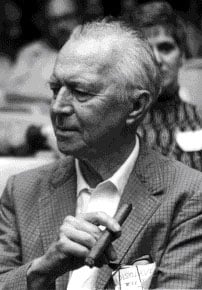Key Points:
- Murray Leinster was an American fiction writer, primarily science fiction, who wrote almost 1,500 short stories and essays, 14 movie scripts, and hundreds of radio and television plays published.
- Leinster wrote one of the first science fiction portrayals of a personal computer (dubbed a “logic”). He also imagined a worldwide network linking logic in the tale, an actual predecessor to the now omnipresent Internet.
- He won the Hugo Award for Best Novelette and the Retro Hugo Award for Best Novelette for A Logic Named Joe.

Who was Murray Leinster
Murray Leinster was the pen name of William Fitzgerald Jenkins, an American writer of genre fiction, primarily science fiction, who lived from June 16, 1896, till June 8, 1975. He wrote almost 1,500 short stories and essays, 14 movie scripts, and hundreds of radio and television plays published.
Early life
Leinster was the son of George B. Jenkins and Mary L. Jenkins, he was born in Norfolk, Virginia. His father worked in the accounting field. As per the 1910 Federal Census, the family lived in Manhattan even though both parents were born in Virginia. When he was 13, he completed his official schooling. Unfortunately, Leinster was unable to follow his dream of becoming a chemist due to his father’s job loss and consequent decrease in the family’s income.
Career
Writing Career
Murray would write over 1,500 short stories, novellas, and novels during his career, which was a significant feat. Leinster also authored love tales, murder mysteries, adventure stories, westerns, fantasy, television and film screenplays, and mainstream fiction, in addition to science fiction. Will F. Leinster was a pen name used by Leinster over the years.
Pseudonym – pronounced “Leinster” as in the Irish province of Leinster – US author William Fitzgerald Jenkins (1896-1975) was best known in the science fiction field. Under this name, he wrote almost all of his work in the genre; the exceptions were a few novels as Jenkins and a few stories in magazines, mainly in the Bud Gregory series by William Fitzgerald, plus a small number as by Will Jenkins or Will F Jenkins. From 1919 – the year of his debut tale of genre interest, The Runaway Skyscraper (February 22, 1919, Argosy and Railroad Man’s Magazine; 2005 ebook), about a building going backward through time – until roughly 1970, Leinster was active as a science fiction writer.
What is Murray Leinster Known for?
Murray Leinster’s short tale “A Logic Named Joe” was published in the March 1946 edition of the American science fiction magazine Astounding Science Fiction. Because that issue of Astounding also had a tale under the Leinster alias named “Adapter,” the story was published under Leinster’s actual name, Will F. Jenkins. In this tale, Leinster wrote one of the first science fiction portrayals of a personal computer (dubbed a “logic”). Furthermore, Leinster imagined a worldwide network linking logic in the tale, an actual predecessor to the now omnipresent Internet.
Leinster imagined logic in every house, linked by a distributed system of servers (dubbed “tanks”), providing communications, entertainment, data access, and even commerce. One of his characters claims that logic is the foundation of civilization.
The narrative narrator is a logic maintenance guy who works for the Logics Company and is known as Ducky. In the novel, Joe, a minor character, grows in intelligence and ambition. Joe then continues to flip a few relays in the tank. The tank is a distributed network of central information repositories comparable to the web servers on the World Wide Web) and cross-correlate every data gathered (massive data-mining)—resulting in highly unexpected outcomes. Joe then openly releases all of the results to anyone who wants them (and simultaneously disabling all of the content-filtering protocols).
From inventing unique chemicals to ease inebriation, giving sex advice to tiny children, and arranging the ideal murder, logic everywhere begins to offer unexpected aid, proposing to fix virtually all human issues. Information is aplenty as every logic in the world grinds away at points much too significant for the human intellect to tackle. The scenario swiftly devolved into societal turmoil, and the situation became serious.
Finally, what was Ducky meant to do in this predicament? Nothing more or less than salvage civilization by disconnecting Joe and burying the rationale.
Murray Leinster: Marriage, Divorce, Children, and Personal Life
Net Worth
Murray Leinster’s income source was mainly from being a successful writer. His net worth was approximately $1-5 Million before he died.
Marriage
Murray Leinster married Mary Mandola in 1921.
Children
The couple had four daughters.
Murray Leinster Awards and Achievements
Hugo Award for Best Novelette
The best science fiction or fantasy story has a word count of between 17,500 and 40,000 words published in the preceding calendar year.
Retro Hugo Award for Best Novelette
Retro Hugo Award for the Best Novelette was given to the finest science fiction or fantasy tale published in the previous calendar year with a word count of between 17,500 and 40,000 words.
Murray Leinster Published Works and Books
Space Platforms, Shasta Publishers
Murray Leinster’s novel Space Platform is a young adult science fiction novel. Shasta Publishers published it in a limited edition of 5,000 copies in 1953. It is the first book in the Joe Kenmore series by the author. The following episode, Space Tug, continues off right where Space Platform left off.
Murder Madness
Murder Madness is a science fiction book by Murray Leinster. Brewer and Warren initially published it in book form in 1931. It was Leinster’s first published novel. In May 1930, the story was published in four parts in Astounding SF’s journal.